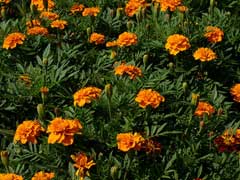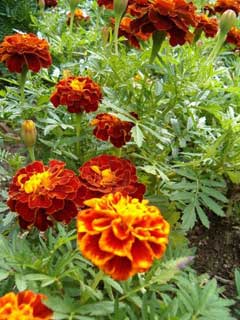 |
|
http://commons.wikimedia.org/wiki/User:EugeneZelenko |
 |
| http://commons.wikimedia.org/wiki/User:BotBln |
Translate this page:
Summary
Bloom Color: Orange, Yellow. Main Bloom Time: Early summer, Early fall, Late summer, Late spring, Mid summer. Form: Upright or erect.
Physical Characteristics

 Tagetes patula is a ANNUAL growing to 0.5 m (1ft 8in) by 0.3 m (1ft) at a fast rate.
Tagetes patula is a ANNUAL growing to 0.5 m (1ft 8in) by 0.3 m (1ft) at a fast rate.
See above for USDA hardiness. It is hardy to UK zone 3 and is frost tender. It is in flower from July to October, and the seeds ripen in September. The species is hermaphrodite (has both male and female organs) and is pollinated by Insects. The plant is self-fertile.
It is noted for attracting wildlife.
Suitable for: light (sandy), medium (loamy) and heavy (clay) soils, prefers well-drained soil and can grow in heavy clay soil. Suitable pH: mildly acid, neutral and basic (mildly alkaline) soils. It cannot grow in the shade. It prefers dry or moist soil.
UK Hardiness Map
US Hardiness Map
Synonyms
Plant Habitats
Cultivated Beds;
Edible Uses
Edible Parts:
Edible Uses: Colouring Condiment Drink
The flowers are used in refreshing drinks[177, 183]. The leaves are used as a food flavouring[183, 238]. No further details are given. The essential oil is used as a food flavouring, though it is inferior to the oil obtained from T. minuta[238]. The dried flowers are an adulterant of saffron(Crocus sativus), used for colouring foods yellow[183, 238].
References More on Edible Uses
Medicinal Uses
Plants For A Future can not take any responsibility for any adverse effects from the use of plants. Always seek advice from a professional before using a plant medicinally.
Aromatic Digestive Diuretic Dysentery Sedative
The whole herb is aromatic, digestive, diuretic and sedative[238]. It is used internally in the treatment of indigestion, colic, severe constipation[238], coughs and dysentery[218]. Externally, it is used to treat sore eyes and rheumatism[238]. The leaves are harvested as required for immediate use during the growing season, whilst the flowering plant can be dried and stored for later use[238].
References More on Medicinal Uses
The Bookshop: Edible Plant Books
Our Latest books on Perennial Plants For Food Forests and Permaculture Gardens in paperback or digital formats.

Edible Tropical Plants
Food Forest Plants for Hotter Conditions: 250+ Plants For Tropical Food Forests & Permaculture Gardens.
More

Edible Temperate Plants
Plants for Your Food Forest: 500 Plants for Temperate Food Forests & Permaculture Gardens.
More

More Books
PFAF have eight books available in paperback and digital formats. Browse the shop for more information.
Shop Now
Other Uses
Companion Dye Essential Insecticide Repellent
Landscape Uses: Border, Container, Foundation, Massing, Seashore, Specimen. A very ornamental plant[1]. Special Features: North American native, Fragrant foliage, Naturalizing, Suitable for cut flowers, Suitable for dried flowers. Secretions from the roots of growing plants have an insecticidal effect on the soil, effective against nematodes and to some extent against keeled slugs[18, 20, 200, 218]. These secretions are produced about 3 - 4 months after sowing[200]. The whole plant is harvested when in flower and distilled for its essential oil[218, 238].The oil is used in perfumery, it is blended with sandalwood oil to produce 'attar genda' perfume[238]. About 35 kilos of oil can be extracted from 1 hectare of the plant (yielding 2,500 kilos of flowers and 25,000 kilos of herbage)[218]. The whole plant contains substances that are toxic to cockroaches[218]. The growing plant repels whitefly and can be grown near tomatoes to keep that crop free of the insect[18, 20]. A yellow dye is obtained from the flowers[169]. It is used to colour foods and textiles[238]. The flowers are sometimes used as an adulterant of saffron (obtained from Crocus sativus)[238]. Dynamic accumulator.
Special Uses
Attracts Wildlife Dynamic accumulator Scented Plants
References More on Other Uses
Cultivation details
Requires a well-drained moderately fertile soil in a sunny position[200]. Grows well in heavy clay soils and in sandy soils[188]. A very ornamental plant[1], there are many named varieties[188]. A good butterfly plant[30]. Removing dead flowers before the seed is formed will extend the flowering season[188]. The bruised leaves emit a refreshing pungent smell[245]. Plants are prone to slugs, snails and botrytis[188]. The French marigold is often used as a companion plant, especially for growing amongst tomatoes and potatoes where it helps to repel pests[238]. See 'Other uses' below for more details. Tagetes patula (French Marigold) is self-fertile, meaning it can produce seeds from its own pollen without requiring cross-pollination. However, like many Tagetes species, it is also pollinated by insects, which can enhance seed production. This makes it a reliable seed-producing plant even when grown in isolation.
References Carbon Farming Information and Carbon Sequestration Information
Temperature Converter
Type a value in the Celsius field to convert the value to Fahrenheit:
Fahrenheit:
The PFAF Bookshop
Plants For A Future have a number of books available in paperback and digital form. Book titles include Edible Plants, Edible Perennials, Edible Trees,Edible Shrubs, Woodland Gardening, and Temperate Food Forest Plants. Our new book is Food Forest Plants For Hotter Conditions (Tropical and Sub-Tropical).
Shop Now
Plant Propagation
Seed - sow March in a greenhouse. Only just cover the seed. Germination usually takes place within 2 weeks. When they are large enough to handle, prick the seedlings out into individual pots and plant them out after the last expected frosts.
Other Names
If available other names are mentioned here
Native Range
NORTHERN AMERICA: Mexico (Durango, Zacatecas, Aguascalientes, Guanajuato, Hidalgo, Jalisco, México, Michoacán de Ocampo, Querétaro)
Weed Potential
Right plant wrong place. We are currently updating this section.
Please note that a plant may be invasive in one area but may not in your area so it's worth checking.
Conservation Status
IUCN Red List of Threatened Plants Status :

Growth: S = slow M = medium F = fast. Soil: L = light (sandy) M = medium H = heavy (clay). pH: A = acid N = neutral B = basic (alkaline). Shade: F = full shade S = semi-shade N = no shade. Moisture: D = dry M = Moist We = wet Wa = water.
Now available:
Food Forest Plants for Mediterranean Conditions
350+ Perennial Plants For Mediterranean and Drier Food Forests and Permaculture Gardens.
[Paperback and eBook]
This is the third in Plants For A Future's series of plant guides for food forests tailored to
specific climate zones. Following volumes on temperate and tropical ecosystems, this book focuses
on species suited to Mediterranean conditions—regions with hot, dry summers and cool, wet winters,
often facing the added challenge of climate change.
Read More
Expert comment
Author
L.
Botanical References
71181
Links / References
For a list of references used on this page please go here
Readers comment
| Add a comment |
|
If you have important information about this plant that may help other users please add a comment or link below. Only comments or links that are felt to be directly relevant to a plant will be included. If you think a comment/link or information contained on this page is inaccurate or misleading we would welcome your feedback at [email protected]. If you have questions about a plant please use the Forum on this website as we do not have the resources to answer questions ourselves.
* Please note: the comments by website users are not necessarily those held by PFAF and may give misleading or inaccurate information.
To leave a comment please Register or login here All comments need to be approved so will not appear immediately.
|
|